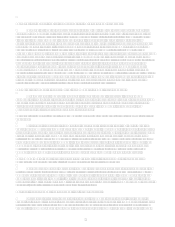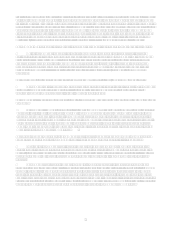Nutrisystem 2003 Annual Report Download - page 20
Download and view the complete annual report
Please find page 20 of the 2003 Nutrisystem annual report below. You can navigate through the pages in the report by either clicking on the pages listed below, or by using the keyword search tool below to find specific information within the annual report. 18
Direct gross margin declined from 56.3% in 2002 to 50.0% in 2003 primarily due to a charge of $529 related to
the write-off of obsolete old program product and packaging and an increase in the proportion of sales that are
discounted under the autoship program.
Direct revenues decreased 2.7% from 2001 to 2002. From 2001 to 2002, the number of new customers
acquired dropped by 14,695 or 37.0%, while the revenue generated from each new customer increased 30.1% from $329
in 2001 to $428 in 2002. Returning customers generated $3.5 million in revenues in 2001 and $5.4 million in revenues
in 2002. Direct revenues declined slightly in the face of a sharp drop in new customers because sales from each new
customer and sales from returning customers increased. The decline in new customers was caused by a large reduction
in marketing spending, which dropped by $2.2 million or 60.9% from 2001 to 2002. The increase in revenues obtained
from each new customer is primarily attributable to the introduction of the autoship program in November 2001, in
which the customer receives monthly product shipments automatically until they notify the Company they wish to end
shipments. Total revenues from returning customers increased as the number of former customers familiar with the
Companys Direct channel increased.
Overview of Television Infomercial Distribution
In the second quarter of 2001, the Company began distribution of its proprietary prepackaged food through
QVC, the shopping television network. In 2003, this channel represented 21% of the Companys net revenue. On the
QVC network, the Company reaches a large, incremental audience in a 50 minute, infomercial format that enables the
Company to convey fully the benefits of the NutriSystem diet foods. Under the terms of the Companys agreement with
QVC, QVC viewers purchase NutriSystem products directly from QVC and are not directed to the NutriSystem web site.
Retail prices (including shipping and handling) offered on QVC to consumers are similar to prices offered on the web
site. The Company generates a lower gross margin (as a percent of sales) on sales to QVC relative to direct sales, but
QVC sales require no incremental advertising and marketing expense and, management believes, exposure on QVC
raises consumer awareness of the NutriSystem brand. Net sales through the television infomercial distribution channel
were $4,617, $7,376 and $2,681 for the years ended December 31, 2003, 2002 and 2001, respectively. Sales declined
from 2002 to 2003 because the Company aired fewer shows on QVC and sales per minute of air-time declined.
Year Ended December 31, 2003 Compared to Year Ended December 31, 2002
Revenues. Revenues decreased from $27,569 for the year ended December 31, 2002 to $22,575 for the year
ended December 31, 2003. The revenue decrease of $4,994, or 18.1%, resulted from decreased sales to QVC ($2,759),
Direct ($1,415), Case Distributor ($553) and the Field Sales channel ($267). In the year ended December 31, 2003,
Direct accounted for 65% of total revenues, while QVC, Field Sales and Case Distributor revenues accounted for 21%,
8% and 6% of total revenues, respectively. In 2002, the comparable percents were 58%, 27%, 8% and 7%, respectively.
Costs and Expenses. Cost of revenues decreased $2,811 from $15,653 to $13,372 for the years ended
December 31, 2002 and 2003, respectively. Gross margin as a percent of revenues decreased from 43.2% in 2002 as
compared to 40.8% in 2003. The decrease in gross margin is attributable to $529 write-off of old program inventory and
packaging recorded in cost of sales. Marketing expenses increased $2,235 from $1,392 to $3,627 from 2002 to 2003.
All marketing spending promoted the Direct, and the increase in marketing is attributable to increased spending for
advertising media ($898), market research and consulting ($529), payroll related to marketing and advertising ($323),
production of television advertising ($299) and Internet advertising ($186). The Company incurred $751 of marketing
expense in the second half of December 2003 related to television media ($55), television production ($193), direct mail
($490) and Internet advertising ($13). Management believes that a significant portion of the revenue generated from this
spending will be recorded in 2004. General and administrative expenses ($7,775 and $7,239 in 2002 and 2003,
respectively) decreased $536 attributable to lower costs associated with the decline in revenues, especially compensation,
and reduced costs associated with the closing of the Reno warehouse in the first quarter of 2003, offset by increased
professional fees and consulting fees. In general and administrative expenses, the Company recorded litigation expense
related to the franchise lawsuit of $302 and $238 in 2002 and 2003, respectively (see Item 3), and $198 expense related
to the Reno warehouse closing costs. Included in general and administrative costs in 2002 are $481 in severance relating
to the Companys former Chief Executive Officer and $175 in charges relating to discontinued packaging and products.
Primarily in the fourth quarter of 2003, the Company incurred $599 in expenses associated with new program
development in order to create the NutriSystem Nourish program. New program expenses include the new package
design costs and development of program specifications. Other expense in 2002 of $100 represents the cost of settling
an employment-related complaint filed by certain employees of the Companys former facility in Reno. For the year
























